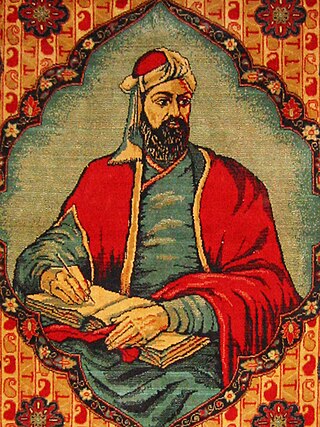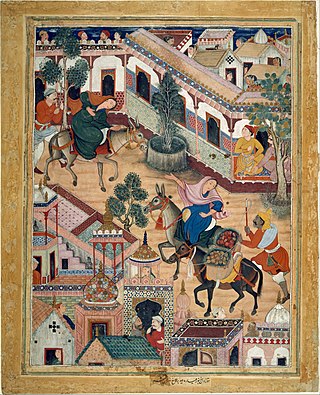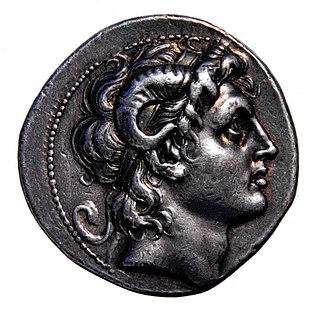Related Research Articles

The Shahnameh, also transliterated Shahnama, is a long epic poem written by the Persian poet Ferdowsi between c. 977 and 1010 CE and is the national epic of Greater Iran. Consisting of some 50,000 distichs or couplets, the Shahnameh is one of the world's longest epic poems, and the longest epic poem created by a single author. It tells mainly the mythical and to some extent the historical past of the Persian Empire from the creation of the world until the Muslim conquest in the seventh century. Iran, Azerbaijan, Afghanistan, Tajikistan and the greater region influenced by Persian culture such as Armenia, Dagestan, Georgia, Turkey, Turkmenistan and Uzbekistan celebrate this national epic.

Nizami Ganjavi, Nizami Ganje'i, Nizami, or Nezāmi, whose formal name was Jamal ad-Dīn Abū Muḥammad Ilyās ibn-Yūsuf ibn-Zakkī, was a 12th-century Muslim poet. Nizami is considered the greatest romantic epic poet in Persian literature, who brought a colloquial and realistic style to the Persian epic. His heritage is widely appreciated in Afghanistan, Republic of Azerbaijan, Iran, the Kurdistan region and Tajikistan.

Persian literature comprises oral compositions and written texts in the Persian language and is one of the world's oldest literatures. It spans over two-and-a-half millennia. Its sources have been within Greater Iran including present-day Iran, Iraq, Afghanistan, the Caucasus, and Turkey, regions of Central Asia, South Asia and the Balkans where the Persian language has historically been either the native or official language.

The Hamzanama or Dastan-e-Amir Hamza narrates the legendary exploits of Hamza ibn Abdul-Muttalib, an uncle of Muhammad. Most of the stories are extremely fanciful, "a continuous series of romantic interludes, threatening events, narrow escapes, and violent acts". The Hamzanama chronicles the fantastic adventures of Hamza as he and his band of heroes fight the enemies.

Abu'l Hasan Yamīn ud-Dīn Khusrau, better known as Amīr Khusrau, sometimes spelled as, Amir Khusrow or Amir Khusro, was an Indo-Persian Sufi singer, musician, poet and scholar, who lived during the period of the Delhi Sultanate.

The story of Dhu al-Qarnayn is mentioned in Surah al-Kahf of the Quran. It has long been recognised in modern scholarship that the story of Dhu al-Qarnayn has strong similarities with the Syriac Legend of Alexander the Great. According to this legend, Alexander travelled to the ends of the world then built a wall in the Caucasus Mountains to keep Gog and Magog out of civilized lands.

'Ali-Shir Nava'i, also known as Nizām-al-Din ʿAli-Shir Herawī was a Timurid poet, writer, statesman, linguist, Hanafi Maturidi mystic and painter who was the greatest representative of Chagatai literature.

Islamic cultures or Muslim cultures refers to the historic cultural practices that developed among the various peoples living in the Muslim world. These practices, while not always religious in nature, are generally influenced by aspects of Islam, particularly due to the religion serving as an effective conduit for the inter-mingling of people from different ethnic/national backgrounds in a way that enabled their cultures to come together on the basis of a common Muslim identity. The earliest forms of Muslim culture, from the Rashidun Caliphate to the Umayyad Caliphate and early Abbasid Caliphate, was predominantly based on the existing cultural practices of the Arabs, the Byzantines, and the Persians. However, as the Islamic empires expanded rapidly, Muslim culture was further influenced and assimilated much from the Iranic, South Asian, Caucasian, Turkic, Malay, Somali, Berber, and Indonesian cultures.

The Alexander Romance is an account of the life and exploits of Alexander the Great. Of uncertain authorship, it has been described as "antiquity's most successful novel". The Romance describes Alexander the Great from his birth, to his succession of the throne of Macedon, his conquests including that of the Persian Empire, and finally his death. Although constructed around a historical core, the romance is mostly fantastical, including many miraculous tales and encounters with mythical creatures such as sirens or centaurs. In this context, the term Romance refers not to the meaning of the word in modern times but in the Old French sense of a novel or roman, a "lengthy prose narrative of a complex and fictional character".

Khosrow and Shirin is the title of a famous tragic romance by the Persian poet Nizami Ganjavi (1141–1209), who also wrote Layla and Majnun. It tells a highly elaborated fictional version of the story of the love of the Sasanian king Khosrow II for the Christian Shirin, who becomes queen of Persia. The essential narrative is a love story of Persian origin which was already well known from the great epico-historical poem the Shahnameh and other Persian writers and popular tales, and other works have the same title.

Rekhta was an early form of the Hindustani language. This style evolved in both the Perso-Arabic and Nagari scripts and is considered an early form of Modern Standard Urdu and Modern Standard Hindi. According to the Pakistani linguist and historian Tariq Rehman, Rekhta was a highly Persianized register of Hindustani, exclusively used by poets. It was not only the vocabulary that was Persianized, but also the poetic metaphors, inspired by Indian landscapes and seasons, were abandoned in favor of the Persian ones i.e. bahaar (spring) replacing barsaat.

Abu Mohammad Moshrefoldin Mosleh ebn Abdollah ebn Mosharraf, better known by his pen name Saadi, also known as Saadi of Shiraz, was a Persian poet and prose writer of the medieval period. He is recognized for the quality of his writings and for the depth of his social and moral thoughts.
Yusuf and Zulaikha is a title given to many tellings in the Muslim world of the story of the relationship between the prophet Yusuf and Potiphar's wife. Developed primarily from the account in Sura 12 of the Qur'an, a distinct story of Yusuf and Zulaikha seems to have developed in Persia around the tenth century CE. According to Agnès Kefeli, "in the biblical and Qur’anic interpretations of Joseph's story, Potiphar's wife bears all the blame for sin and disappears quickly from the narrative". But "in Turkic and Persian literatures, Joseph and Zulaykha do, ultimately, become sexually united, in parallel to their noncorporeal mystical union". The story of Yusuf and Zulaikha is subsequently found in many languages, such as Arabic, Persian, Bengali, Turkish, Punjabi and Urdu. Its most famous version was written in the Persian language by Jami (1414–1492), in his Haft Awrang.

The vast conquests of the Macedonian king Alexander the Great quickly inspired the formation and diffusion of legendary material about his deity, journeys, and tales. These appeared shortly after his death, and some may have already begun forming during his lifetime. Common themes and symbols among legends about Alexander include the Gates of Alexander, the Horns of Alexander, and the Gordian Knot.

Alexander the Great was a king of ancient Greece and Macedon who forged one of the largest empires in world history. Soon after his death, a body of legend began to accumulate about his life and exploits. With the Greek Alexander Romance and its translation into numerous languages including Armenian, Syriac, Arabic, Persian, Ethiopic, and more, an entire genre of literature was dedicated to the exploits of Alexander in both Christian and Muslim realms. Alexander was also the one most frequently identified with Dhu al-Qarnayn, a figure that appears in Surah Al-Kahf in the Quran, the holy text of Islam, which greatly expanded the attention paid to him in the traditions of the Muslim world.
The Iskandarnameh is a poetic production in the Alexander Romance tradition authored by the Persian poet Nizami Ganjavi that describes Alexander the Great as an idealized hero, sage, and king. More uniquely, he is also a seeker of knowledge who debates with great philosophers Greek and Indian philosophers, one of them being Plato.
The Ayina-i Iskandarī is a Persian legend of the life and exploits of Alexander the Great composed by the poet Amir Khusrau, completed in 1299/1300 during the reign of Muhammad II of Khwarazm. It is presented in the form of 35 discourses, running at 4,416 verses in the 1977 edition of the text produced by Jamâl Mirsaydof. Like his predecessor Nizami Ganjavi, Amir Khusrau's Alexander legend formed the fourth part of his Khamsa, and it was the first response to Nizami's Iskandarnameh. The text expresses a wish for the peace and stability brought about by Alexander as opposed to the period of instability and political turnover of his own time, and makes frequent reference to the "second Alexander" as a means of addressing his ruler Muhammad II, who assumed that title for himself during his reign.
The eleventh-century Shahnameh of Ferdowsi preserves the earliest version of the Alexander Romance in the Persian language, following closely the text in its Syriac translation. The Romance genre functioned to preserve and describe the legends and exploits of Alexander the Great. Although the Shahnameh is a much larger text and contains legends of many other rulers of Greater Iran, three consecutive sections of it cover Alexander, amounting to ~2,500 verses. Furthermore, the sections about Alexander act as a bridge between the narratives of the kings before and after him, representing a transition from a realm of mythological kings and exploits to the historical kings of the Sasanian Empire.
The Kherad-nâme-ye Eskandari of Abd-al-Rahmân Jâmi is a piece of Persian literature which existed as an heir to the tradition of the Khamsa of Nizami Ganjavi. It constitutes the final book of Jami's larger seven-book composition, his Haft Awrang. More specifically, it focuses on legends of Alexander the Great as recounted in Nizami's Iskandarnameh and ultimately in the tradition of the Alexander Romance genre of literature. Jami's representation of the genre offers his readers a spiritual reflection on Alexander's journeys interspersed with long philosophical meditations exemplified through short anecdotes (hekâyat). As with other Islamic authors of this era, Alexander is ultimately identified with Dhu al-Qarnayn in his construction of the eastern wall against Gog and Magog.
Ayina-i Iskandari may refer to:
References
- ↑ Hanaway, William L. (1998). "ESKANDAR-NĀMA". Encyclopedia Iranica. Retrieved 2024-03-08.
- 1 2 Casari, Mario (2023). "The Alexander Legend in Persian Literature". In Ashtiany, Mohsen (ed.). Persian narrative poetry in the classical era, 800-1500: romantic and didactic genres. A history of Persian literature / founding editor - Ehsan Yarshater. London New York Oxford New Delhi Sydney: I.B. Tauris. pp. 513–514. ISBN 978-1-78673-664-2.